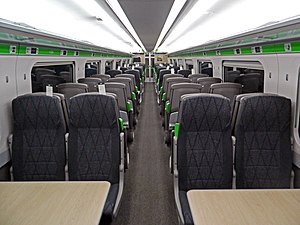| British Rail Class 802 | |
|---|---|
 Great Western Railway Class 802 at Par | |
 The standard-class interior of a GWR Class 802 unit | |
| In service | 2018–present |
| Manufacturer | Hitachi Rail |
| Built at | |
| Family name | A-train |
| Replaced | |
| Constructed | 2017–2020 |
| Number built |
|
| Formation | |
| Fleet numbers |
|
| Capacity | |
| Owners |
|
| Operators | |
| Depots |
|
| Lines served | |
| Specifications | |
| Car body construction | Aluminium |
| Car length |
|
| Doors | Single-leaf pocket sliding (2 per side per car) |
| Maximum speed | 125 mph (200 km/h)[8] |
| Weight |
|
| Prime mover(s) | MTU 12V 1600 R80L[10] (3 per 5-car unit, 5 per 9-car unit) |
| Engine type | 4-stroke V12 turbo-diesel with SCR[11] |
| Displacement | 21 L (1,284 cu in) per engine[11] |
| Power output | 700 kW (940 hp) per engine |
| Acceleration | 1 m/s2 (2.2 mph/s) |
| Electric system(s) | 25 kV 50 Hz AC overhead |
| Current collector(s) | Pantograph |
| Safety system(s) | |
| Coupling system | Dellner 10[12] |
| Multiple working | Within class |
| Track gauge | 1,435 mm (4 ft 8+1⁄2 in) standard gauge |
The British Rail Class 802[13][14] is a type of high-speed bi-mode multiple-unit passenger train designed and produced by the Japanese manufacturer Hitachi Rail. It has been operated by Great Western Railway, TransPennine Express, and Hull Trains; each of these train operating companies has given its own units a unique brand: Great Western Railway's units are branded Intercity Express Trains (IETs),[15] TransPennine Express units are branded Nova 1s[4] and Hull Trains' units are branded Paragons.[16]
The Class 802 is based on the design of the Hitachi A-train, being a member of the Hitachi AT300 product family.[17] They are near-identical to the preceding Class 800, the primary difference between the two being the diesel engines originally set to a higher power output and enlarged fuel tanks for their intended use on lengthier unelectrified stretches of railway. The introduction of Class 802s by Great Western Railway facilitated the replacement of ageing Intercity 125 high-speed trains, and enabled a reduction of journey times.
Various enhancement and modification schemes have been both implemented and proposed. Both Great Western Railway and TransPennine Express have agreed to participate in trials of battery train technology that, dependent on results, may see fleetwide adoption. In the event of large-scale electrification being funded and implemented during the train's service life, it is practical for some of the engines to be removed from Class 802 sets if rendered surplus, which would reduce their overall weight by 15% and thus raise operational efficiency. Furthermore, while the Class 802s presently have an initial maximum speed of 125 mph, if infrastructure upgrades were to permit greater speeds at a future date, they have the capability of being modified for operating at 140 mph.[18]
- ^ Clinnick, Richard (October 2023). "TPE confirms Nova 3 withdrawal plan". Rail Express. No. 329. p. 8.
- ^ a b c d "Class 802". London: Eversholt Rail Group. Archived from the original on 28 July 2021. Retrieved 3 February 2020.
- ^ a b "Our Fleet - Class 802". London: Angel Trains. Archived from the original on 4 August 2021. Retrieved 20 January 2022.
- ^ a b "Meet the Nova 1". London: First TransPennine Express. Archived from the original on 29 September 2022. Retrieved 5 December 2022.
- ^ Paragon Seating Plan by Carriage (PDF) (4th ed.). London: Hull Trains. 23 December 2019. Archived (PDF) from the original on 20 January 2022. Retrieved 20 January 2022.
- ^ Cite error: The named reference
lairawas invoked but never defined (see the help page). - ^ a b Marsh, Stuart (8 July 2019). "New Era at Doncaster Carr". Rail Engineer. Retrieved 20 January 2022.
- ^ "Speed limiters for Hitachi fleets". Traction & Stock. The Railway Magazine. Vol. 168, no. 1457. August 2022. p. 92.
- ^ "Table 1: Inter City Express classes 800, 801 and 802" (PDF). RailEngineer. October 2017.
- ^ MTU Rail Power for the UK & Ireland (PDF). MTU Friedrichshafen GmbH. September 2018. p. 2. Archived from the original (PDF) on 3 December 2022. Retrieved 3 December 2022.
- ^ a b Diesel Engine 12V 1600 for Railcar Applications (EU Stage IIIB) (PDF) (01/19 ed.). MTU Friedrichshafen GmbH. Archived (PDF) from the original on 9 January 2021. Retrieved 20 January 2022.
- ^ Pritchard, Robert (2021). British Railways Locomotives & Coaching Stock 2021. Sheffield: Platform 5 Publishing. p. 390. ISBN 978-1-909431-86-7.
- ^ Pritchard, Robert (February 2016). "The Future for Intercity Travel". Today's Railways. No. 170. Sheffield. pp. 40–43.
- ^ "Directions in respect of a track access contract between Network Rail Infrastructure Limited and Hull Trains Company Limited" (PDF). Office of Rail and Road. 2 March 2016. Retrieved 19 April 2016.
- ^ "New Intercity Express Train carries passengers for the first time" (Press release). Great Western Railway. 21 August 2018. Archived from the original on 31 March 2019. Retrieved 31 March 2019.
- ^ "Hull Trains reveals name of new fleet". Hull Trains. 2019. Retrieved 28 August 2019.
- ^ "AT300 for the West of England". Hitachi Rail EU. Retrieved 31 March 2019.
- ^ Cite error: The named reference
railmag 2019was invoked but never defined (see the help page).